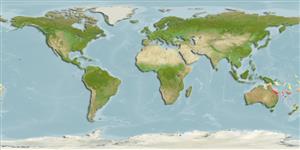Classification / Names
Noms communs | Synonymes | Catalog of Fishes(Genre, Espèce) | ITIS | CoL | WoRMS | Cloffa
>
Pleuronectiformes (Flatfishes) >
Soleidae (Soles)
Etymology: Aseraggodes: Greek, aggos, -eos, -ous = vessel, uterus, carapace of a crab + Greek, aseros, -a, -on = to remove the appetite (Ref. 45335).
More on author: Ogilby.
Environment: milieu / climate zone / depth range / distribution range
Écologie
marin démersal; profondeur 2 - 25 m (Ref. 57560). Subtropical
Southwest Pacific: Lord Howe Island and New Caledonia.
Taille / Poids / Âge
Maturity: Lm ? range ? - ? cm
Max length : 6.4 cm SL mâle / non sexé; (Ref. 57560)
Description synthétique
Morphologie | Morphométrie
Rayons mous dorsaux (Total): 69-72; Rayons mous anaux: 47 - 50; Vertèbres: 36. Diagnosis: Dorsal rays 69-72, branched except first 14-22 rays; anal rays 47-50, all but branched; caudal rays 18 (uppermost and lowermost two rays simple, middle 12-14 double branched); pelvic rays 5. Lateral-line scales on ocular side 86-88, including 12 anterior to a vertical at upper end of gill opening; scales with 10-14 cteni; scales progressively shorter anteriorly on head and with fewer cteni; 2 rows of scales in narrowest interorbital space, with small scales in 4 or 5 rows extending onto median and anterior edges of eyes. Broad lappet-like cirri on ventral margin of head. Vertebrae 36; dorsal pterygiophores anterior to fourth neural spine 13- I 4 (14 in holotype). Body depth 2.4-2.6 in SL; head length (HL) 4.45-4.5 in SL; upper lip slightly overhanging lower lip when mouth closed; eye diameter 4.05-4.65 in HL; posterior edge of upper eye over middle of lower eye; interorbital space narrow, the least vertical distance separating eyes 12.3-13.3 in HL; lateral line angling upward anteriorly, directed toward dorsal edge of upper eye; ventral edge of lower eye about one-half eye diameter above upper end of gill opening. Caudal peduncle present, its length 8.1-10.8 in HL; longest dorsal ray 1.65-1.7 in HL; caudal fin rounded, 3.85-3.95 in SL. Ocular-side pelvic fin on ventral edge of body and slightly anterior to fin of blind side, the second or third ray longest, 2.3-2.35 in HL, the tip reaching to base of second or third anal rays; small scales extending nearly to dorsal-fin margin anteriorly on both sides, the scale coverage gradually reduced to fifteenth to 20th ray, and absent posteriorly. A thin membranous lengthwise ridge basally on dorsal and anal rays, disappearing posteriorly; a dark brown cirrus occasional on membranous ridges of dorsal rays on ocular side. Color of holotype in alcohol pale yellow with many small black spots and short wavy lines on head and body, that on the lateral line take the form of streaks extending from two to five scales (Ref. 57560).
Collected from sandy bottom (Ref. 57560).
Life cycle and mating behavior
Maturité | Reproduction | Frai | Œufs | Fécondité | Larves
Randall, J.E. and R.C. Meléndez, 1987. A new sole of the genus Aseraggodes from Easter Island and Lord Howe Island, with comments on the validity of A. ramsaii. Bishop Mus. Occas. Pap. 27:97-105. (Ref. 10634)
Statut dans la liste rouge de l'IUCN (Ref. 130435)
Menace pour l'homme
Harmless
Utilisations par l'homme
Plus d'informations
PaysZones FAOÉcosystèmesOccurrencesIntroductionsStocksÉcologieRégime alimentaireÉléments du régime alimentaireConsommation alimentaireRation
Noms communsSynonymesMétabolismePrédateursÉcotoxicologieReproductionMaturitéFraiRassemblement de ponteFéconditéŒufsDéveloppement de l'œuf
Taille/ÂgeCroissanceLongueur-poidsLongueur-longueurFréquences de longueursMorphométrieMorphologieLarvesDynamique des populations larvairesRecrutementAbondanceBRUVS
RéférencesAquacultureProfil d'aquacultureSouchesGénétiqueElectrophoresesHéritabilitéPathologiesTraitementNutrientsMass conversion
CollaborateursImagesStamps, Coins Misc.SonsCiguateraVitesseType de nageSurface branchialeOtolithesCerveauxVision
Outils
Articles particuliers
Télécharger en XML
Sources Internet
Estimates based on models
Preferred temperature (Ref.
123201): 17.1 - 27.7, mean 25.4 °C (based on 303 cells).
Phylogenetic diversity index (Ref.
82804): PD
50 = 0.5000 [Uniqueness, from 0.5 = low to 2.0 = high].
Bayesian length-weight: a=0.00977 (0.00473 - 0.02021), b=3.07 (2.90 - 3.24), in cm total length, based on LWR estimates for this (Sub)family-body shape (Ref.
93245).
Niveau trophique (Ref.
69278): 3.4 ±0.5 se; based on size and trophs of closest relatives
Résilience (Ref.
120179): Haut, temps minimum de doublement de population inférieur à 15 mois (Preliminary K or Fecundity.).
Fishing Vulnerability (Ref.
59153): Low vulnerability (10 of 100).
